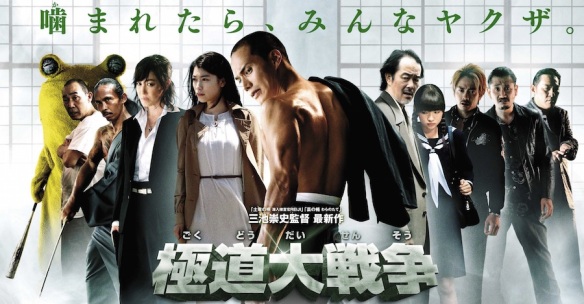 The Earth is under attack. Alien parasites have wormed their way into the brains of uncountable human beings, everybody from policemen to school teachers to noodle sellers. Teenager loser Shinichi (Shota Sometani) knows this because of a fatal flaw in the alien scheme – they can’t crawl in through your ears if you’re wearing headphones. Instead, his attacker Migi (Sadao Abe) misses Shinichi’s brain at the fateful moment and takes over his right hand, bonding them together for life.
The Earth is under attack. Alien parasites have wormed their way into the brains of uncountable human beings, everybody from policemen to school teachers to noodle sellers. Teenager loser Shinichi (Shota Sometani) knows this because of a fatal flaw in the alien scheme – they can’t crawl in through your ears if you’re wearing headphones. Instead, his attacker Migi (Sadao Abe) misses Shinichi’s brain at the fateful moment and takes over his right hand, bonding them together for life.
Shinichi now has a wise-cracking alien attached to his arm, curious about world affairs, human relationships, and genitals. But he also has an ally in the war with the aliens, since Migi’s botched takeover turns him into a pro-human fifth columnist. Shinichi must somehow find out the aliens’ plans, without alerting the suspicions of his school teacher Miss Tamiya (Eri Fukatsu), whose blank-faced stare is sure-fire evidence that she has already had her brain eaten.
Japan’s first riff on Invasion of the Body Snatchers came in the form of the as-yet untranslated Beautiful Star by the infamously loopy novelist Yukio Mishima, in which a group of fanatical nerds became convinced that they are Venusian agents tasked with starting a nuclear war. The same period, the 1960s, also saw the granddaddy of all tales of alien symbiosis, when the dying alien Ultraman fused himself inextricably with a passing human, kicking off an ongoing franchise of transforming heroes fighting rubber monsters. By the 1970s, Japanese children’s telly was awash with the likes of School in Peril, in which teenage angst found new outlets in missions to defy scheming adults who turned out to be alien stooges.
In 1988 when the manga artist Hitoshi Iwaaki published the first chapter of Kiseiju (Parasyte – the misspelling is a deliberate imitation of a similar twist in the original Japanese), his story was a knowing homage to such childhood chillers. But running in Afternoon, a comic magazine for adults, Parasyte injected heavy doses of body-horror and paranoia. In gleeful, blood-spattered imitation of John Carpenter’s The Thing, Iwaaki’s aliens let rip with visceral, fanged transformations, like weaponised Salvador Dali paintings duking it out for control of the Earth. But it was also witty. Migi’s oddball friendship with Shinichi was genuinely charming, and their encounters with the humourless alien invaders inevitably creepy or inadvertently funny.
The original Parasyte manga finished in 1995, fading from public view for the oddest of reasons. For several years, the remake rights were purportedly in the hands of James Cameron. The Titanic director’s interest in manga is well-documented, but in the case of Parasyte, the rights acquisition may have been part of a complex legal issue, acquiring it to prevent ambulance-chasing lawsuits about the similarities between its shape-shifting aliens and the abilities of the T2000 in Terminator 2. There were certainly moments in the manga that bore a coincidental resemblance to iconic scenes in Cameron’s 1991 movie, and as a result, Parasyte stayed out of other media for over 20 years. Despite winning awards in comic form and bagging itself a Seiun (Japan’s Hugo award) for best science fiction, it didn’t make the obvious jump to anime or feature film until 2014, when it suddenly exploded into both formats. This delay has done it no harm at all, not the least in its evocations of modern terrorism – Shinichi is a double agent inside a sleeper cell, committed to preventing atrocities on his home turf.
As if two movies were not enough, Parasyte was also adapted as animation – arguably a medium more suited to the sudden outbreaks of alien shape-shifting. But Takashi Yamazaki’s live-action version also benefits from a generation of falling prices in digital effects, allowing him to inject heavy doses of rubber-bodied violence. It doesn’t always work, with the nature of Migi’s host leading Shinichi to literally hold his assailants at arm’s length, but most of the time, talky scenes of threats and scheming convincingly erupt into savage collisions of snapping flesh, often part-hidden in the shadows or obscured on scratchy CCTV.
Jonathan Clements is the author of Anime: A History. This article first appeared in Geeky Monkey #7, 2016.



 In 1638, the ruler of Japan ordered a crusade against his own subjects, a holocaust upon the men, women and children of a doomsday cult.
In 1638, the ruler of Japan ordered a crusade against his own subjects, a holocaust upon the men, women and children of a doomsday cult. 
